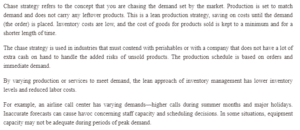The Chase Strategy
Seasonal demand fluctuates production, and strategies such as chase and level production help regulate production fluctuation. Implementing a chase-demand strategy helps match the market and does not carry any leftover products; chase-demand allows cost-saving until the order is placed (Collier & Evans, 2019). A level production strategy produces the same number of units, and industries use this strategy for cyclical markets and when production capabilities are capped or limited (Collier & Evans, 2019).
Reducing waste is an area where businesses can improve, and implementing the chase demand strategy at a major airline call center can help with seasonal fluctuation. With a chase-demand system, the “workforce level is changed to meet, or chase, demand,” which will help staff the correct number of employees during peak seasons (Jamalnia, Yang, Xu, & Feili, 2017). Call center attrition constantly fluctuates; airline call centers can hire seasonal workers by implementing this strategy. Recruiting can focus on hiring college students on break, part-time employees or retired employees looking to generate extra money during the summer or holidays. By implementing this strategy, the call center will not be over-staffed during the off-season. Still, it will be adequately staffed during peak season, which can help reduce waste to avoid incurring unnecessary costs.
References
Collier, D. A, & Evans, J. R. (2019). Operations and Supply Chain Management. Cengage Learning.
Jamalnia, A., Yang, J.-B., Xu, D.-L., & Feili, A. (2017). Novel decision model based on a mixed chase and level strategy for aggregate production planning under uncertainty: A case study in the beverage industry. Computers & Industrial Engineering, 114, 54–68. https://doi.org/10.1016/j.cie.2017.09.044
ORDER A PLAGIARISM-FREE PAPER HERE
We’ll write everything from scratch
Question
Chase strategy refers to the concept that you are chasing the demand set by the market. Production is set to match demand and does not carry any leftover products. This lean production strategy saves costs until the request (the order) is placed. Inventory costs are low, and the cost of goods for products sold is kept to a minimum and for a shorter time.

The Chase Strategy
The chase strategy is used in industries that must contend with perishables or with a company that does not have a lot of extra cash on hand to handle the added risks of unsold products. The production schedule is based on orders and immediate demand.
By varying production or services to meet demand, the lean inventory management approach has lower inventory levels and reduced labor costs.
For example, an airline call center has varying demands—higher calls during summer months and major holidays. Inaccurate forecasts can cause havoc concerning staff capacity and scheduling decisions. In some situations, equipment capacity may not be adequate during periods of peak demand.

